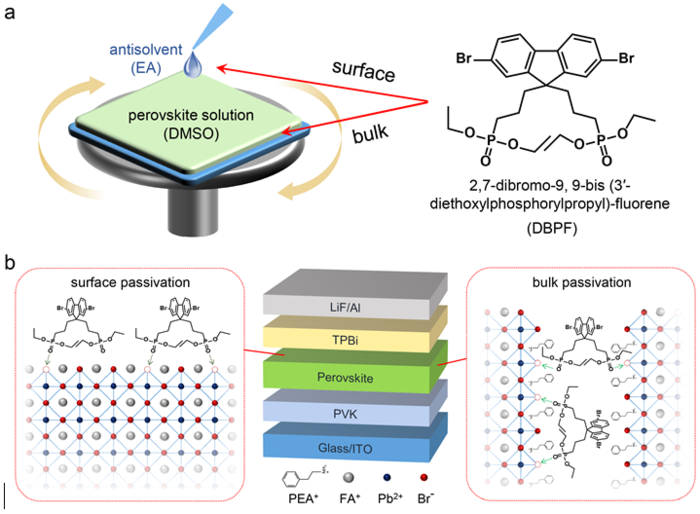Low-cost, strong photoluminescence quantum yield and excellent color purity define metal halide perovskites. Perovskite light-emitting diodes have made rapid progress in recent years, with intriguing applications in lighting and display.
 A preparation of quasi-2d perovskite film and molecular chemical structure of DBPFpassivation agent. B schematics of device structure and passivation mechanisms. Image Credit: Dezhong Zhang, Yunxing Fu, Hongmei Zhan, Chenyang Zhao, Xiang Gao, Chuanjiang Qin, Lixiang Wang
A preparation of quasi-2d perovskite film and molecular chemical structure of DBPFpassivation agent. B schematics of device structure and passivation mechanisms. Image Credit: Dezhong Zhang, Yunxing Fu, Hongmei Zhan, Chenyang Zhao, Xiang Gao, Chuanjiang Qin, Lixiang Wang
However, there is a dearth of systematic research on the ubiquitous temperature-induced fluorescence quenching in perovskite emitters, and techniques to reduce thermal quenching need to be further explored.
A team of Chinese Academy of Sciences researchers led by Professor Chuanjiang Qin of Changchun Institute of Applied Chemistry created a passivation approach for quasi-2D perovskite emitters to analyze the correlation between defects and thermal quenching. The study was published in Light: Science & Applications.
Alkyl phosphates were chosen as passivation functional groups for the passivation agent of 2,7-dibromo-9,9-bis (3′-diethoxylphosphorylpropyl)-fluorene (DBPF) for effective defect passivation without impacting perovskite crystallization, which is useful for investigating the direct connection between thermal quenching and defects.
Furthermore, DBPF may be dissolved in both perovskite precursor solvent and antisolvent to achieve bulk and surface passivation, which is useful for furthering research into the interaction between flaws in various landscapes and performance characteristics, particularly thermal stability.
The following mechanisms are hypothesized based on the extensive impacts of passivation on thermal quenching characteristics:
“Defect-induced exciton-phonon coupling in the emitting region of quasi-2D films will aggravate the nonradiative recombination of an exciton, leading to severe thermal quenching. When the temperature is higher than 115 °C, higher-energy phonons will lead to the irreversible damage of emitting region in quasi-2D perovskite films, and this degradation can also be inhibited by defect passivation.”
Surface passivation, bulk passivation and dual passivation can raise EQE peak values to 21.5%, 19.3% and 22.2%, respectively, compared to 18.1% for the control device. At 85 °C, the device with dual passivation can sustain 80 % of the total initial EQE, which is significantly greater than the control device’s 17%.
“Our passivation strategy improves the performance of the device working at high temperature, and it is direct evidence to prove that thermal quenching is closely related to defects,” the researchers concluded.
Journal Reference:
Zhang, D., et al. (2022) Suppressing thermal quenching via defect passivation for efficient quasi-2D perovskite light-emitting diodes. Light: Science & Applications. doi.org/10.1038/s41377-022-00761-4.